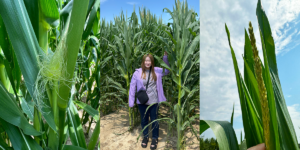By Heather Jennings, PE

BOD5 effluent issues have several different causes. One of the biggest reasons is short circuiting of the lagoon, either by poor design or due to solids build up. Basically, the treatment process can be cut sometimes to over half of the original intended hydraulic detention in the extreme cases by either issue. Poor design can be overcome by adding baffles and strategically placed mixers or aerators. Solids build up can be handled by dredging, but this usually requires extended closure and, at the least, plastic liner replacements. If you are looking at 30%–50% or more organic solids in your sludge, give me a call as we can break them down with Bio Energizer® without taking your system offline!
Flipping or turnover of the lagoons can also be responsible for high BOD5 levels going out the door. Typically, this occurs due to different thermal strata within the water column, meaning that there are different temperatures throughout the lagoon. When the temperatures start warming in the spring or cooling off in the fall, and you add wind action, the bottom or benthic layer of a lagoon with solids comes to the surface. With turnover you lose dissolved oxygen throughout the water column, which reduces solids reduction and can allow solids to leave with the lagoon effluent. Let’s not forget the odors that come with it! As this is entirely driven by ambient temperature, the only tried and true way to overcome this phenomenon is to increase mixing and circulation throughout the lagoon. This is accomplished by adding mixers—or aeration and mixers—but sometimes the expense is more than small communities can handle. Reducing solids can also help reduce the odors.
High BOD5 values can also be due to high levels of total suspended solids (TSS), which is another method of measuring the efficacy of your lagoon’s treatment. Algae, floc, plant materials, and inorganics such as sand and silt can drive TSS up and potentially exceed permit requirements for effluent. This will more likely happen when the benthic layer at the bottom of the lagoon is agitated by turnover or newly added mixers, etc. I have even seen issues due to wildlife “enjoying” the water and stirring things up!
I recommend utilizing both BOD5 and TSS when analyzing your lagoon wastewater treatment system by using the TSS:BOD5 ratio. If it’s less than 1.0, you could have benthic feedback. If you have 1.0 then you are looking at short-circuiting issues. Normal operations have a ratio of 1.5, but if you are over a ratio of 2.0 start looking at algae blooms, surfacing benthic solids, or over aeration. If you see surfacing algae and solids, then a ratio of 2.0 will not surprise you.
What can you do to address some of these issues? If it’s algae overgrowth you might have to use an algaecide, although remember prevention is always better than letting it get out of control. Solids—as I mentioned before—can be removed physically by dredging or with a biostimulant product such as Bio Energizer®. Either way, solids removal helps prevent these issues as well as a host of other issues. If all else fails, give us a call! We’d love to help before you develop ulcers or you fail to hit or exceed your permit limits!
Related Posts

This Week in Ag #20
Wheat harvest is well underway throughout the country. Each morning, the harvest process begins with equipment maintenance. Most farmers and custom cutters will park their fleet in a row, or in close proximity, so they can readily perform daily service. This involves the grease gun. Combines have hundreds of moving parts. Some of the most key...

Heather Jennings Is Featured Guest on “Better Together” Podcast
Paper360, a bimonthly magazine for the pulp & paper industry, produces a podcast called “Better Together: Conversations With Innovative Leaders.” At a recent podcast recorded live at SuperCorrExpo in Orlando, Fla., Heather Jennings, Director of Probiotic Solutions and Host of our own Water Break Podcast, was interviewed on the topic of diversity and innovation for...

This Week in Ag #21
You’ve all heard the saying “knee-high by the fourth of July” to describe the progress of a corn crop. It’s a phrase many folks still refer to today. But as the photo below shows, that saying is now laughable. In fact, if you’re a Midwest farmer and your corn is now knee high, it’s probably in big...

